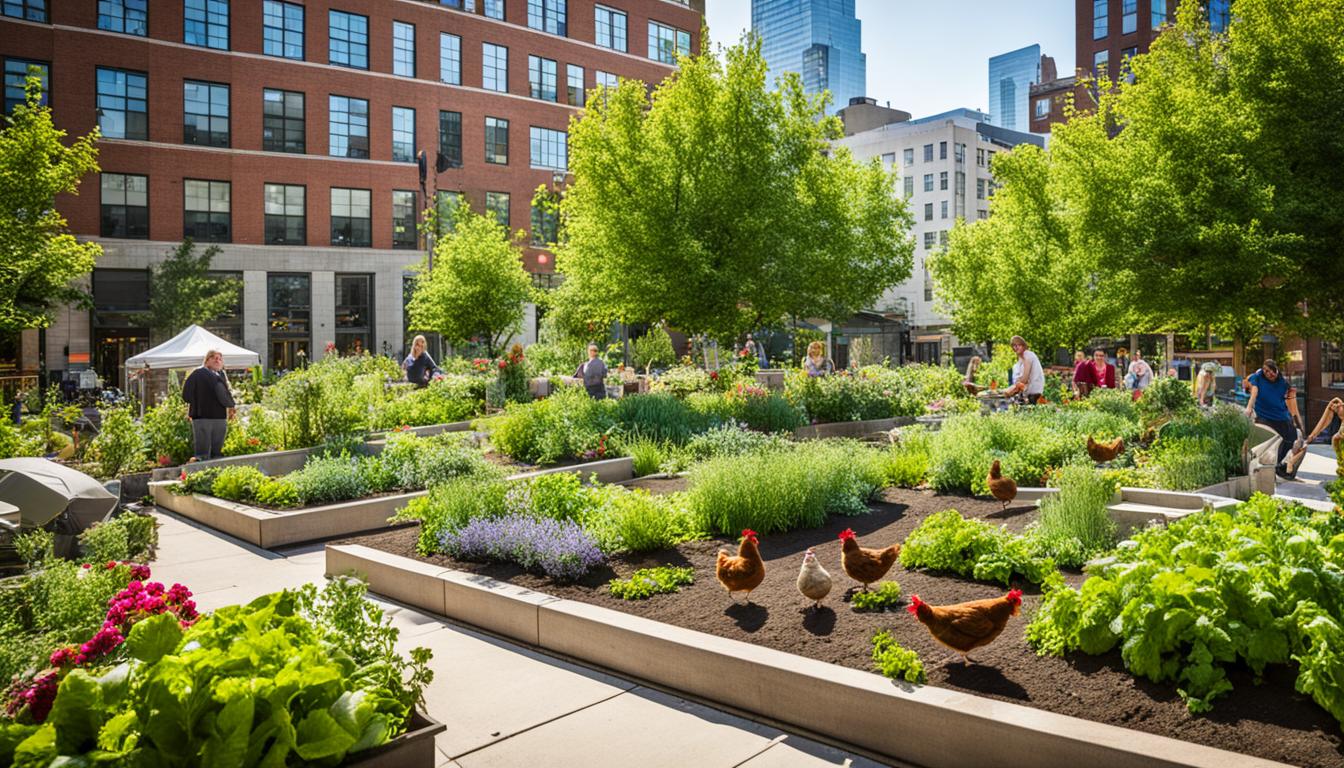Urban Homesteading: Growing food, raising animals, and sustainable living in urban environments.
How can folks in the city make their small spots into places that help them live by growing their own food and being self-sufficient?
Urban Homesteading takes old ways of living off the land and adapts them for city life. More people in cities want to live in a way that helps the planet. They’re turning their balconies, roofs, and shared spaces into green oases. Here, they grow food, keep animals, and take care of the earth.
But, living this way in the city isn’t simple. There’s not much room, and rules can get in the way. You have to be smart and strong to make it work. In this lifestyle, finding ways to garden, save water, use clean energy, and make less trash is key. It’s about making the most with what you have and being mindful of the resources we use.
City dwellers are finding new ways to grow food in small areas. They use things like pots, boxes, and special setups like hydroponics to turn every corner into a mini farm. This not only provides fresh food but is also a clever answer to living in places where there’s not a lot of room.
Key Takeaways
- Urban Homesteading involves transforming small urban spaces into productive, self-sufficient areas.
- Challenges include limited space, local ordinances, and municipal regulations.
- Innovative methods such as container gardening and vertical gardening are essential.
- Sustainable practices like composting and water conservation are integral to reducing an environmental footprint.
- Benefits include increased food security, reduced ecological impact, and a strengthened sense of community.
Introduction to Urban Homesteading
Urban homesteading is a thriving trend in cities. It urges people to live self-sufficiently and eco-friendly. It involves growing food locally, saving water and energy, and managing waste smartly. This lifestyle is great for urbanites who want to help their city’s ecosystem.
What Is Urban Homesteading?
Urban homesteading is about turning city spaces into more than just homes. It’s about creating places that support themselves. People do this through urban gardening and using urban foraging to find local food.
Adding to this, places like community gardens are key. They are not just about growing food. They also bring people together and help them share resources. This strengthens the community.
Historical Context and Evolution
Urban homesteading really took off starting in 2009. It’s grown a lot since then. For example, in Australia, a project started small but soon grew big.
They went from a basic garden to having a big rainwater tank, solar panels, and fruit trees in a few years. They even built a greenhouse by 2013. These changes show how urban homesteading has embraced a big-picture, eco-friendly view.
Urban vs. Rural Homesteading
Urban and rural homesteading have similar goals but work in different ways. Urban homesteading relies more on community help and shared resources. It uses small spaces wisely for gardening.
In contrast, rural homesteads have more room. But despite space constraints, urban homesteading brings people together. It makes food locally, which cuts down on environmental harm and boosts community safety.
Assessing Your Urban Space for Homesteading
Turning your urban space into a homestead has many steps. You need to understand how to plan your space. You also have to follow local regulations. And don’t forget to reach out to your community for help.
Space and Spatial Planning
Optimizing space is crucial for urban homesteading. You can grow your own food even in tight spaces. For apartment dwellers, techniques like vertical gardening work well. And if you have a bigger area, you can grow more things.
Efficient use of space boosts your harvest. This is true for any size property.
Local Regulations and Zoning Laws
Knowing the laws for urban homesteading is important. This helps avoid fines. Some cities have rules about what you can grow or raise. Learning these rules makes things easier and safer for you.
Community Resources and Support
Homesteading is better with others. Urban areas often have resources to share, like tools and workshops. By joining local groups, you can swap produce and seeds. This not only promotes eco-friendly living. It also builds a sense of community and supports sustainability.
| Urban Homesteading Elements | Details |
|---|---|
| Space Optimization | Techniques like vertical gardening and hydroponics |
| Local Ordinances | Compliance with zoning laws and regulations |
| Community Support | Shared tools and educational workshops |
| Collaborative Homesteading | Fostering community through shared efforts |
Optimizing Limited Space for Urban Gardening
Living in cities often means having little room for gardens. Yet, people find clever ways to make lots from a little. They use special tricks to grow beautiful gardens, even in tight spots.
Container and Vertical Gardening
Container gardening is great for city dwellers with limited outdoor space. It allows control over the soil and water used, fitting into any urban area. You can grow many plants, from vegetables to fruit trees, in pots. Plants like tomatoes and potatoes do especially well in pots, giving plenty of produce from small places.
Then, there’s vertical gardening. It’s a smart way to use the wall space to grow more food. Smith (2018) found it can boost food production by 30%. Plus, Despommier (2010) says it helps cool the city and create a more pleasant living environment.
Advantages of Container and Vertical Gardening:
- Enhanced control over soil quality and watering
- Ability to grow various plants in limited spaces
- Utilization of underused vertical space
- Improvement of urban air quality with 20% decrease in CO2 levels (Viljoen & Bohn, 2013)
Hydroponics and Aquaponics
Hydroponics and aquaponics are high-tech ways to grow food without soil. In hydroponics, plants are fed by a nutrient-rich water solution. Aquaponics adds fish that nourish the plants and each other. These methods help urban gardeners produce more food sustainably. By using water and resources efficiently, they make the most of their small spaces.
Choosing the Right Plants and Livestock
Picking the best plants and animals is key for a successful city garden. Choose plats that are small, don’t get sick easily, and like the shade. For example, tiny tomatoes and small veggies are great for little spaces. Also, consider small animals like chickens or quails if you’re into that. It’s all about choosing things that fit well in the city and help your garden thrive.
Optimized Small-Space Gardening Table:
| Method | Benefits | Statistics |
|---|---|---|
| Container Gardening | Control over soil and water, versatility | Utilized by 70% of urban gardeners |
| Vertical Gardening | Maximizes vertical space, reduces heat island effect | 30% increase in food production, 50% heat reduction |
| Hydroponics | Soil-less, high yield | Adopted by 15% of urban homesteaders |
| Aquaponics | Integrated systems, sustainable | Reducing water usage by 90% |
By adopting these methods, anyone can turn a small city space into a bountiful garden. It makes growing food in the city not just doable but also enjoyable. Trying different approaches and learning from them is the way to a thriving urban garden.
Sustainable Practices in Urban Homesteading
Urban homesteaders aim to lessen their impact and live more self-sustainably. They do this by being careful with waste, saving water, and using renewable energy. Let’s look at the main ways they achieve this.
Composting and Waste Management
Composting helps waste minimization and benefits the environment. By using anaerobic composting and vermicomposting, homesteaders transform kitchen scraps into rich soil. This means less trash, better soil for plants, and fewer chemicals needed.
Water Conservation Techniques
Conserving water is key for those living in urban areas. Rainwater harvesting collects water from the roof to reduce the need for new water. Greywater systems take used water and use it for the garden, saving even more water.
Renewable Energy in Urban Settings
Using green energy solutions is vital for urban farmers. Solar panels on roofs capture energy from the sun to cut power bills. This lessens the use of fossil fuels, making the city cleaner and greener.
| Practice | Benefit |
|---|---|
| Composting | Reduces waste and enriches soil |
| Rainwater Harvesting | Conserves water and irrigates plants |
| Solar Panels | Offsets energy costs and reduces carbon footprint |
Benefits of Urban Homesteading
Urban homesteading is packed with benefits for people, the environment, and our wallets. It encourages us to live in a greener and more self-sufficient way, helping the planet. By growing our own food, we cut down on our carbon footprint and eat better. Plus, we feel more connected to what we eat. This fits in perfectly with the move towards eating local, which many cities support.
It also does a lot for making our cities better places to live. Places like community gardens and urban farms bring people together. There, neighbors share what they’ve grown and what they know. These spots make areas look better, cut down on crime, and make communities feel tighter. They help make sure we can get fresh food close to home, reducing our need for big food companies.
Economically, urban homesteading is a win. It saves on bills by using smart practices for water and waste. It also means we spend less at the store for food. This is good for each of us and our families. But it’s also good for the area as a whole. Urban farms can create jobs and teach people new skills. So, this way of living doesn’t just make cities better. It makes us better at handling what the world throws at us, money-wise.
Source Links
- Navigating Urban Homesteading Challenges: Strategies for Success
- Urban Homesteading For Beginners: 21 Ideas & How To Start
- Urban homesteading
- Urban Homesteading – A Story of Soil & Soul
- Engagement Rings – Wedding Rings & Fine Jewelry
- The Urban Homestead (Expanded & Revised Edition): Your Guide to Self-Sufficient Living in the Heart of the City|Paperback
- How to Start Urban Homesteading When You Live in a City | Homeownership Hub
- Urban Homesteading – Tips for Small Space Self-Sufficiency
- Embracing Sustainable Living: A Guide to Urban Homesteading
- Vertical Gardens and Urban Farming
- The new wave of urban farming (and fresh food from small spaces!)
- Urban Gardening 101: Tips for Growing Your Own Food in Tiny Spaces
- Embracing Sustainable Living: A Guide to Urban Homesteading
- What Is Urban Homesteading and How Do You Start?
- Best Practices for the Sustainable Urban Farm
- What is Urban Homesteading?
- The real value of urban farming. (Hint: It’s not always the food.)
- 29 Surprising Benefits Of Urban Farming







